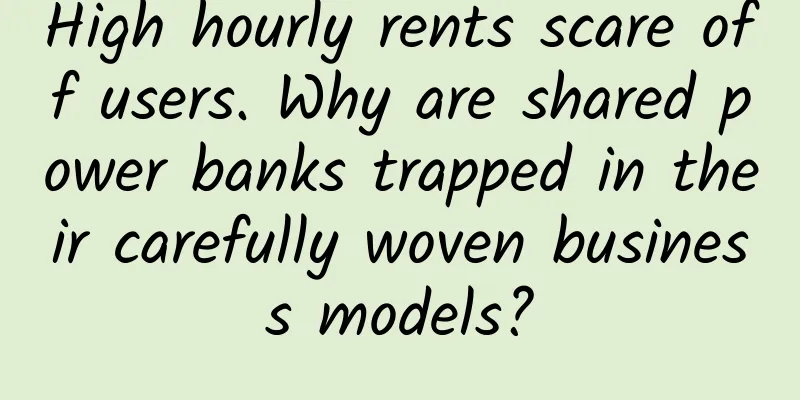High hourly rents scare off users. Why are shared power banks trapped in their carefully woven business models?

|
The ever-increasing prices of shared power banks are not a good business. As a new business model born from the sharing economy, shared power banks and shared bicycles have witnessed the peak of my country's Internet economy. However, with the collapse of the Ofo bike and Mobike's commitment to Meituan, the shared bicycle market has been reshuffled, and the sharing economy has also become a mess. To this day, when the deposit for the Ofo bike will be refunded is still a concern for many consumers. Compared with the development of shared bicycles, the pace of shared power banks is undoubtedly much more stable. According to Toubao data, the cumulative transaction orders of my country's shared power bank industry have reached nearly 800 million in the first half of 2022. With the popularization of smartphones, shared power banks have also become a part of life. With the expansion of shared power bank companies in recent years, the shared power bank market has now entered a mature stage. In the first half of this year, the GMV of the shared power bank industry CR4 accounted for 93.6%, the order volume accounted for 92.7%, and the equipment volume accounted for 90.9%. From the perspective of market structure, the "double-leading" market pattern led by Monster Power and Zhumang Technology has also begun to emerge. However, even though the shared power bank market is developing steadily, as the charging standards continue to rise, shared power banks have become the "price assassins" denounced by the public. Some time ago, taking advantage of the popularity of the topic of "price assassins", consumers complained about being stabbed by them. They questioned the charging standards of shared power banks and expressed confusion about the high fees charged by companies. So, what is the real reason behind the high charges for shared power banks? Agent transformation leads to loss of pricing powerIn the face of public outcry against shared power banks, some industry insiders said that the high fees for shared power banks are rooted in the business model of the companies. At the beginning of the development of the shared power bank market, in order to quickly seize high-quality merchants, brand owners chose the expansion strategy of high commissions and high entry fees. However, with the continuous increase in offline locations, the disadvantages of the above strategy began to emerge. Specifically, the direct sales model based on the above strategy requires not only the brand owners to develop a sales team, but also to bear the upfront costs such as entry fees. For start-up shared power bank companies, the direct sales model is like fighting on multiple fronts. While they pay huge capital costs, they also have to spend a lot of energy on market development. Then, with the substantial expansion of the market scope, brands began to transform to the super-agent model. Compared with the previous direct sales model, brands only need to play the role of supporters in the agent model. The agent will do the market development work for him. Taking Monster Charging, the first shared power bank, as an example, it added 1,800 points in Q2 2020, 70% of which were completed by agents. From the efficiency level, the agency model is obviously higher than the direct sales model. However, the efficiency improvement brought by the agent comes at a price. Specifically, under the agency model, brands support, agents distribute goods, and merchants share profits, forming a solid interest group. In order to gain market share, some brands and agents have reached an agreement on a 20:80 split. Among them, agents take the majority and brands take the minority. It is worth noting that under the previous direct sales model, the commissions and other fees paid by brands to merchants only accounted for 60% of their income. For agents, the substantial profit concessions from brands have injected strong impetus into their expansion. However, for brands, the radical profit-sharing method not only makes them give up their original profits, but also makes them lose their pricing power in disguise. Under the three-party game, brands, agents and merchants must raise prices if they want to make profits. Take Jiedian as an example. In four years, its charging standards have been adjusted three times. In 2018, Jiedian's charging standard in Shanghai was still 1 yuan per hour; in 2019, Jiedian's charging standard changed to 1.5 yuan for half an hour; in 2020, Jiedian's charging standard was changed to "free for the first 5 minutes, and 2 yuan per hour after that"; in 2021, Jiedian's charging standard was changed to "2 yuan per 30 minutes, 4 yuan per hour". It is worth noting that the charging standards for shared power banks vary in different consumption scenarios. For example, the price of shared power banks in daily shopping malls is 4 yuan per hour, while the price of shared power banks in high-speed rail stations and airports is 8 yuan per hour. From the perspective of demand, shared power banks can be said to have accurately grasped the needs of consumers. However, these price changes have not created huge profits for brand owners. Take Monster Charging as an example. Even in 2019 and 2020, when the company was profitable, the company's revenue was only 167 million yuan and 75.427 million yuan respectively. Recently, Monster Charging's second-quarter financial data showed that the company's revenue fell sharply during the reporting period, and the company's net loss was as high as 184.5 million yuan. Single business hits ceilingIf the business model is the handcuffs that restrict the development of shared power bank companies, then the single business model is the anklet that restricts them. With the intensification of market competition, the defects of shared power bank companies in terms of business model have also been magnified. In order to find a second curve for corporate development, the two leading companies in the shared power bank market, one cross-border sales of liquor, and the other toy with new hardware. However, judging from consumer reactions, their transformation still seems to be lacking in consideration. As early as 2020, Monster Charging began to develop its brewing business. The company's liquor product "Kai Huan" is now on sale at the Tmall flagship store. Monster Charging CEO Cai Guangyuan once publicly stated that Kai Huan will be the company's first attempt to find a second growth curve. However, judging from the sales of the product, Monster Charging's attempt is not optimistic. From a business perspective, it is very difficult for Monster Technology to try to cross over to the liquor market. As we all know, liquor products have a strong brand effect. Therefore, whether it can be welcomed by consumers has become the primary problem facing Kaihuan. In recent years, apart from Jiang Xiaobai, few new products have emerged in the liquor market. Compared with Jiang Xiaobai, which is positioned as a bottled liquor, Kaihuan, which is priced at 248 yuan, is more popular with consumers. In contrast, Zhumang Technology's exploration of the second growth curve is more pragmatic. Through modular product design, Zhumang Technology has achieved a flexible combination of shared power banks with smart terminals such as mask machines, tissue boxes, eco-friendly bags, advertising machines, and AED defibrillators, giving shared power banks more practical functions. However, for consumers, although these innovations of Zhumang Technology are novel, they do not solve their consumption pain points. In fact, consumers do not need innovations like Zhumang Technology. Their primary purpose of using shared power banks is to charge. However, in the process of using the products, in addition to bearing high fees, they also have to face consumer pain points such as slow charging and difficult return. From the above perspective, although the use scenarios of shared power banks have been expanded with the efforts of Zhumang Technology, the consumer experience criticized by consumers still exists. Obviously, the latter will still affect consumers' choices. As the market concentration of shared power banks increases, Monster Power and Zhumang Technology are seeking transformation because they need to prove the profitability of their companies to the capital market. However, judging from the frequency of use, shared power banks have not formed a rigid demand with users. At the same time, with the improvement of smartphone battery life and the development of fast charging technology, shared power banks also lack the conditions to become a necessity. It can be seen that the profitability of shared charging is limited, and the two companies must find a second growth curve if they want to prove their profitability. However, for the two companies, in addition to cross-border and innovative attempts, they seem to pay more attention to their As a winner of Toutiao's Qingyun Plan and Baijiahao's Bai+ Plan, the 2019 Baidu Digital Author of the Year, the Baijiahao's Most Popular Author in the Technology Field, the 2019 Sogou Technology and Culture Author, and the 2021 Baijiahao Quarterly Influential Creator, he has won many awards, including the 2013 Sohu Best Industry Media Person, the 2015 China New Media Entrepreneurship Competition Beijing Third Place, the 2015 Guangmang Experience Award, the 2015 China New Media Entrepreneurship Competition Finals Third Place, and the 2018 Baidu Dynamic Annual Powerful Celebrity. |
<<: Apple Watch long-term test report: Usage scenarios are limited
>>: Rolls-Royce's domestic sales in May 2024 fell 53.3% month-on-month, with only 57 units sold
Recommend
9 knowledge points for marketers in 2020!
2020, the sky is full of black swans. The economy...
Red envelopes are rolling in! Have you used these new features of WeChat?
The Spring Festival is just a few days away, and ...
Lanzhou WeChat legal consultation mini program function, how much does it cost to make a legal consultation mini program?
With the continuous improvement of the rule of law...
How is the advertising fee of Douyin Star Map calculated? Douyin Star Chart Advertising Fee Billing Method Revealed
Self-media and short videos are very popular nowa...
Why is frozen shrimp so unpalatable? You are missing these steps
Shrimp pre-cooking is troublesome, so fully proce...
Throwing a baby dolphin to death like a ball! How terrible is it that the killer whale has been focusing on bullying for 60 years?
On July 25, 2022, killer whale researcher Deborah...
How does QR code marketing increase the scanning rate?
In the future, data will serve as a factor of pro...
AMD Fury X computing performance test: violent GTX 980 Ti
Based on different test items, AMD Fury X and NVI...
Why would bugs suddenly appear in well-sealed rice?
This article was reviewed by Liu Shaowei, Deputy ...
Will Martians obey Earth’s control in the future? Can Musk’s Mars colonization plan be realized?
This article is based on answering similar questi...
6 ways to increase the conversion rate of promotion pages by 30 times!
I once worked for an online education company. Th...
Thanksgiving marketing tactics, take it and thank you!
The annual Thanksgiving is coming again! Is the p...
Is Dong Mingzhu making a mistake by failing to diversify her cross-border business?
"There's no way I'm going to buy a G...
Five rules to start your growth hacking journey
The Origins of Growth Hacking Originated from Sil...
Taiyuan quickly ranks and dominates the screen, and a detailed explanation of the B2B website ranking and dominance operation case!
Using independent websites for keyword ranking (S...









